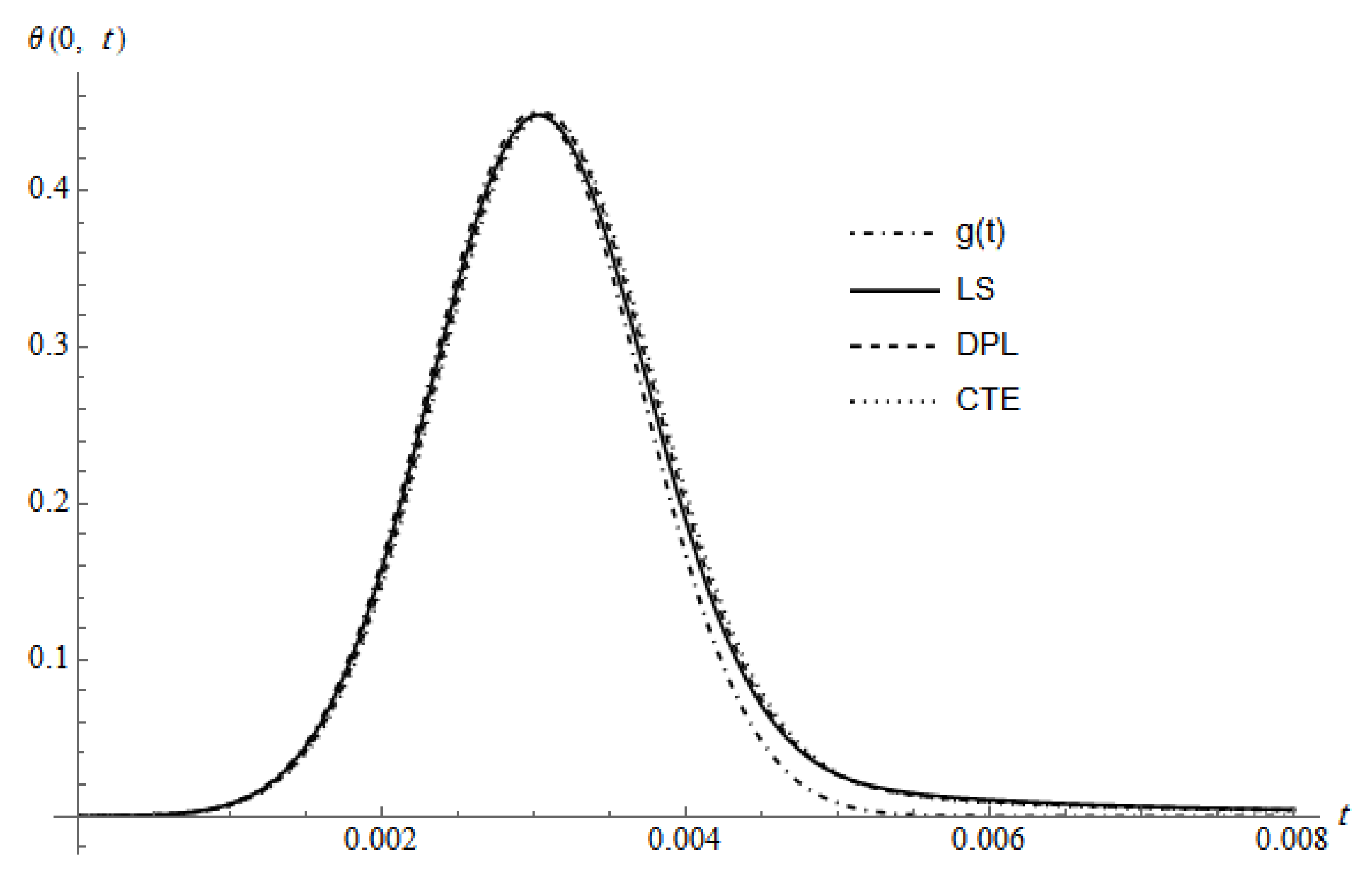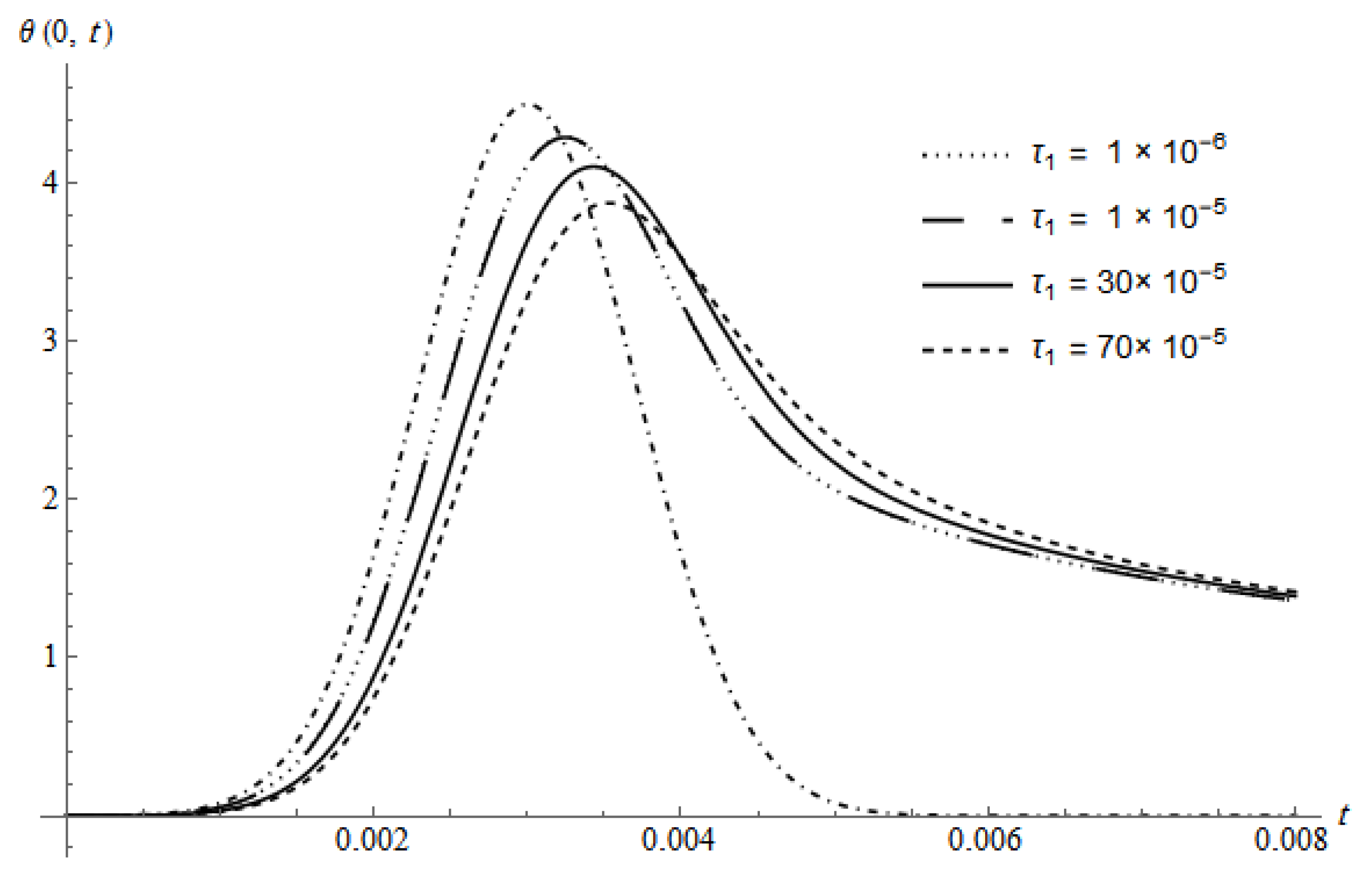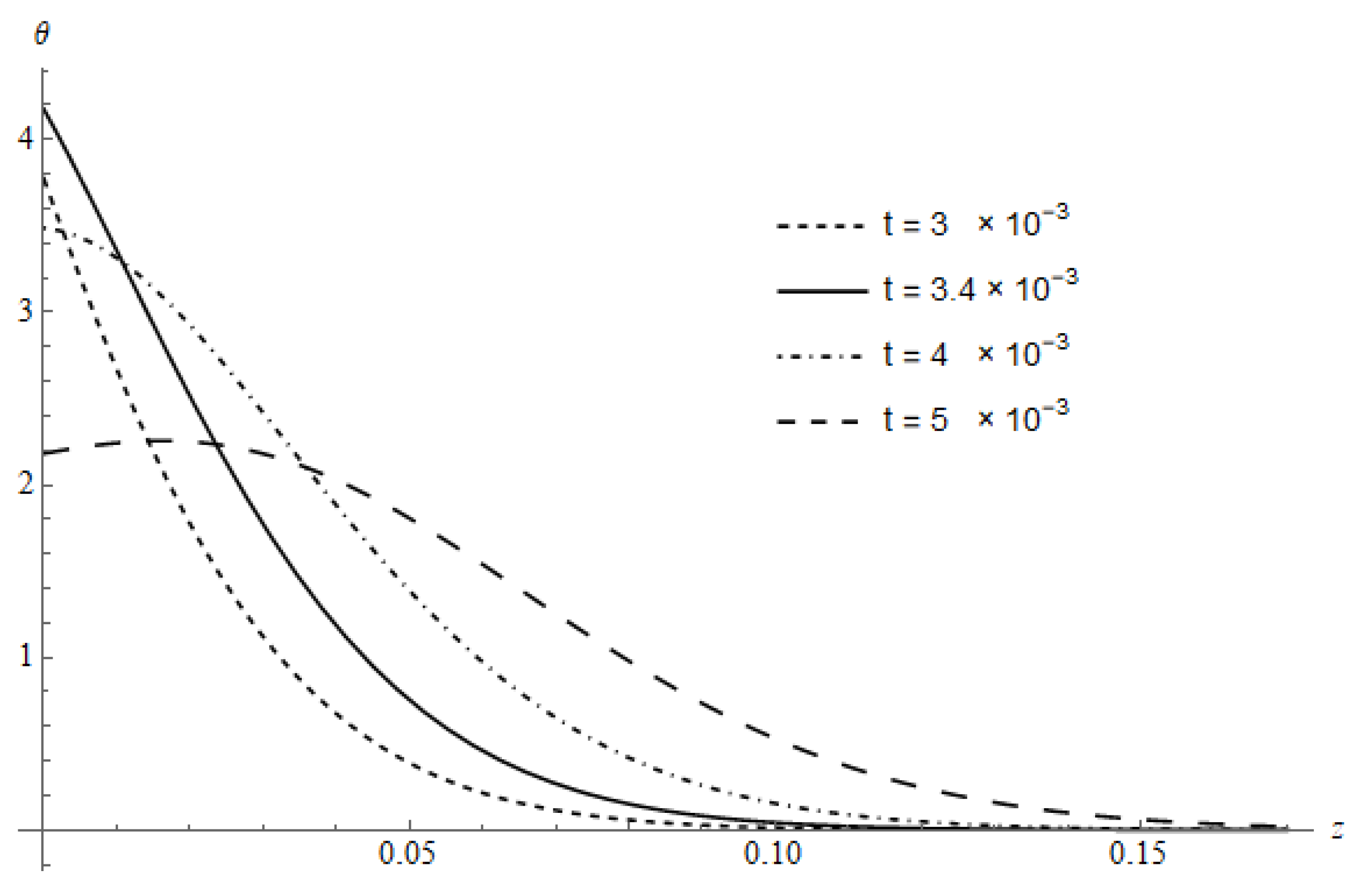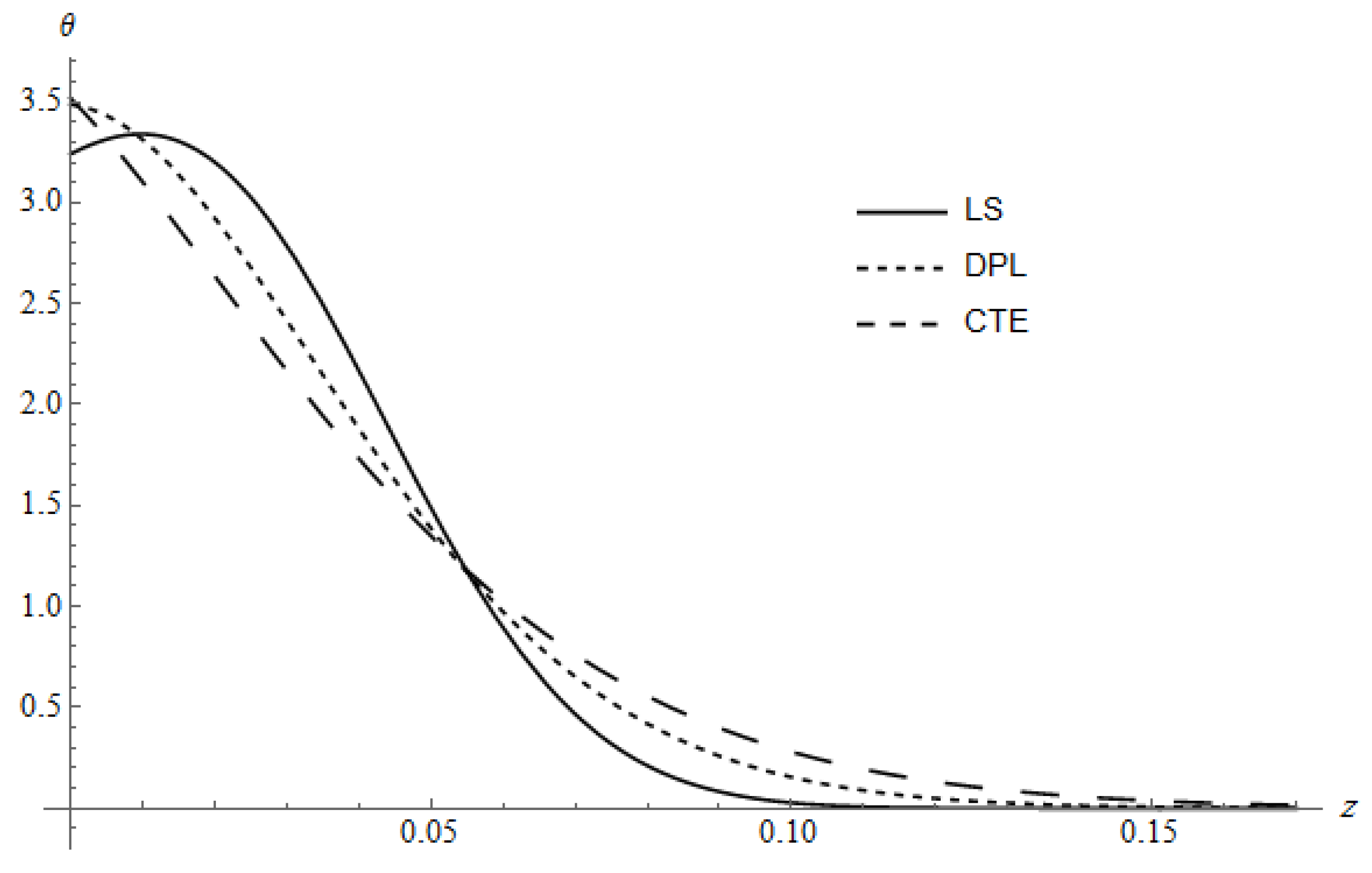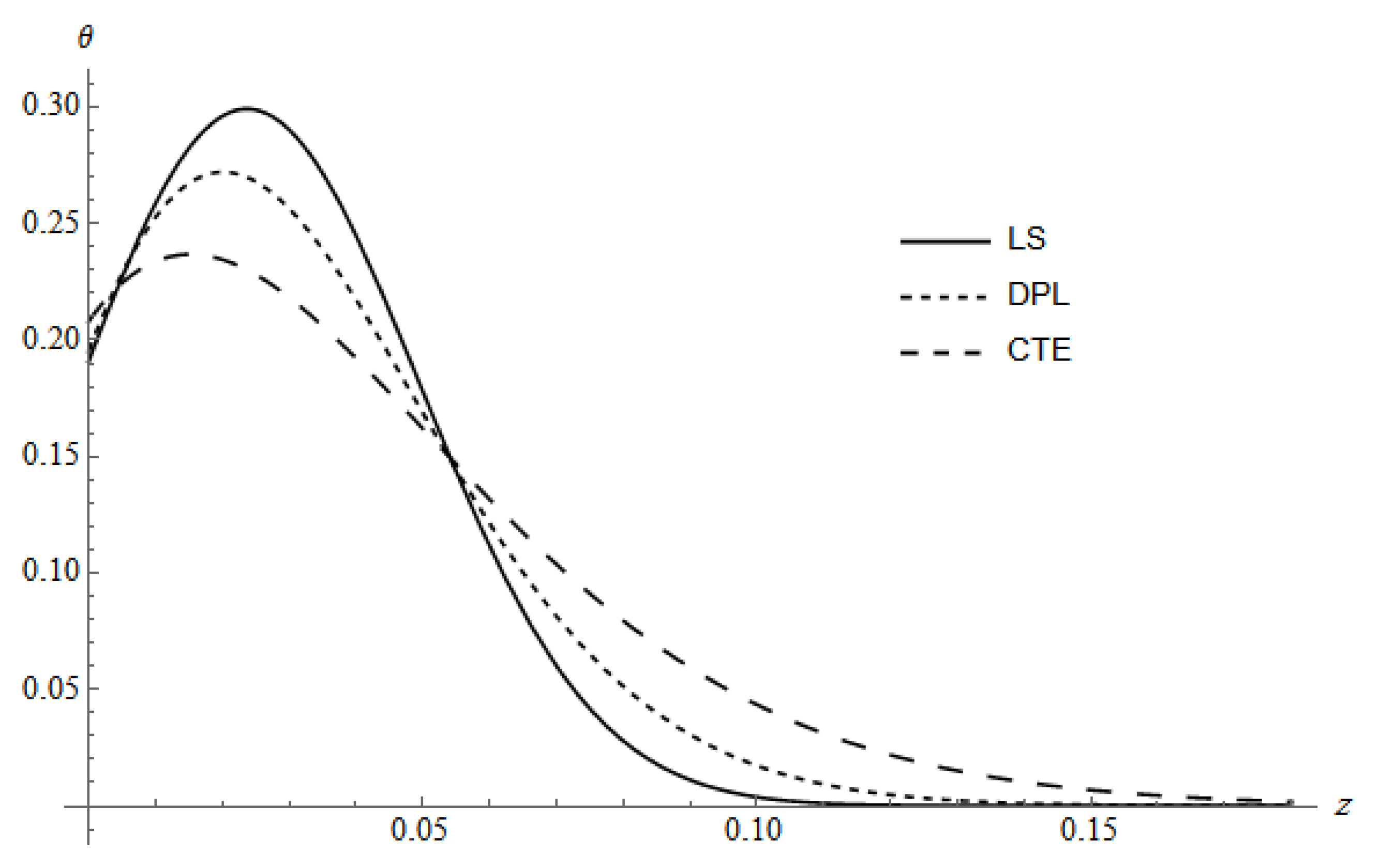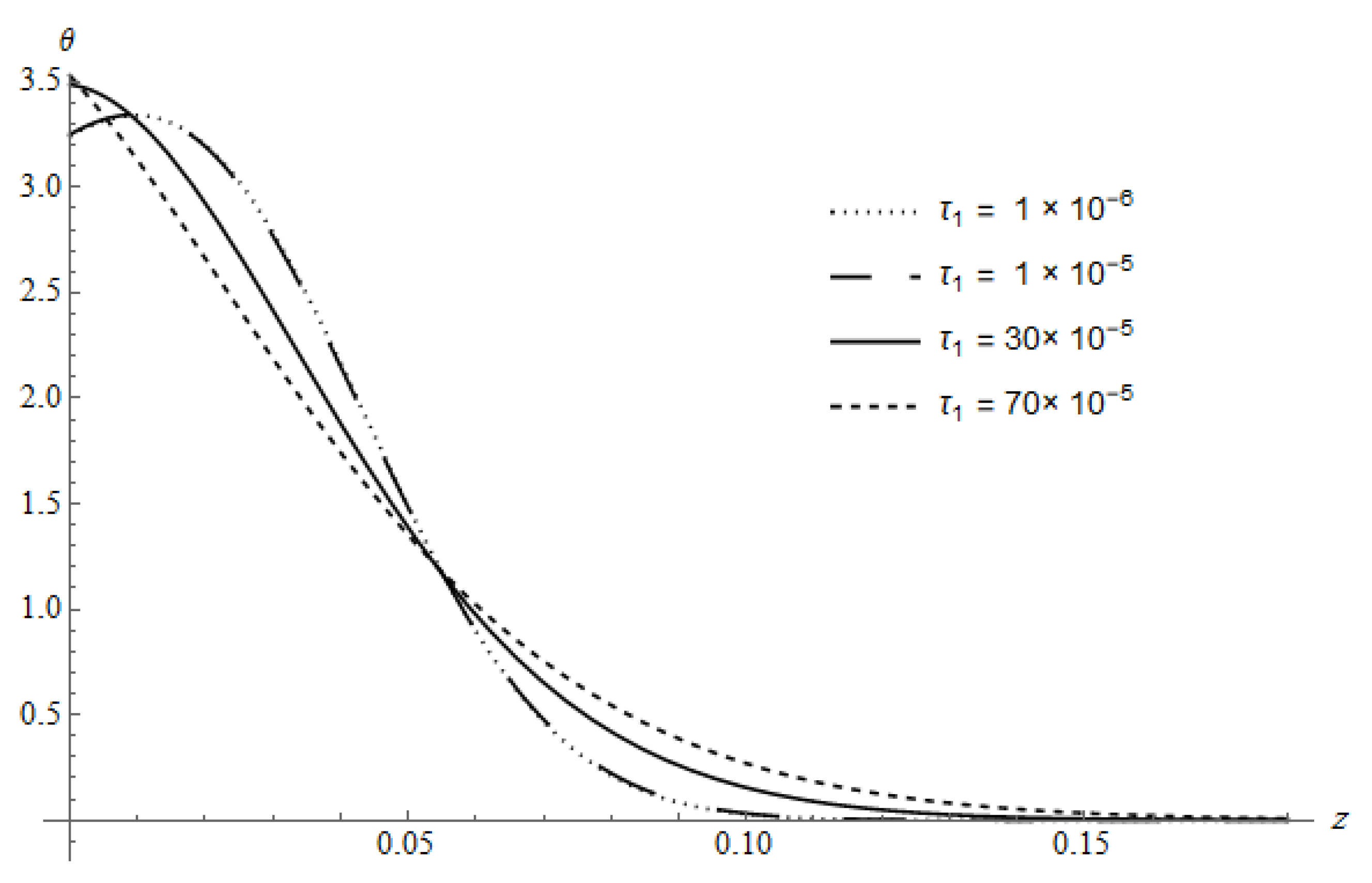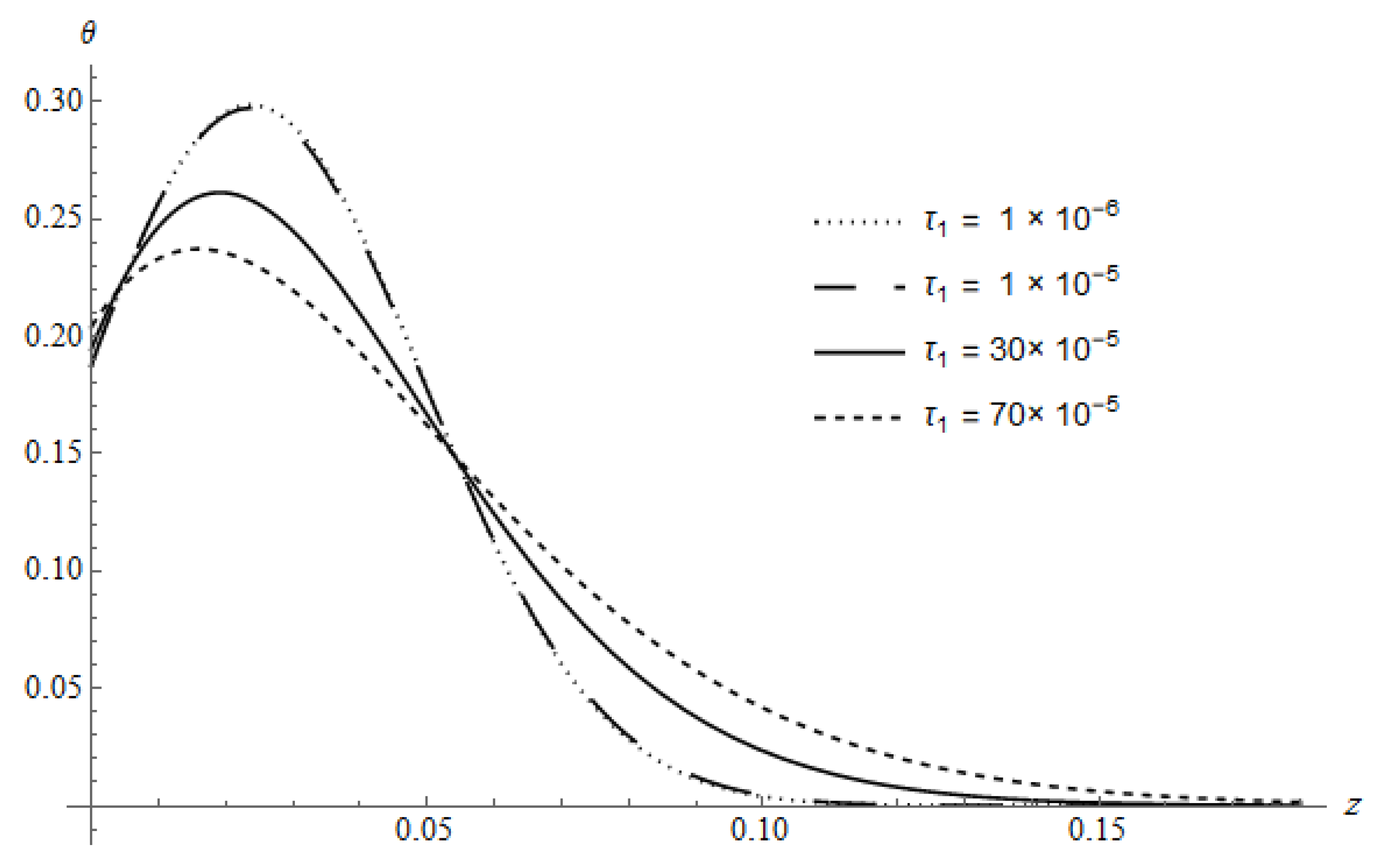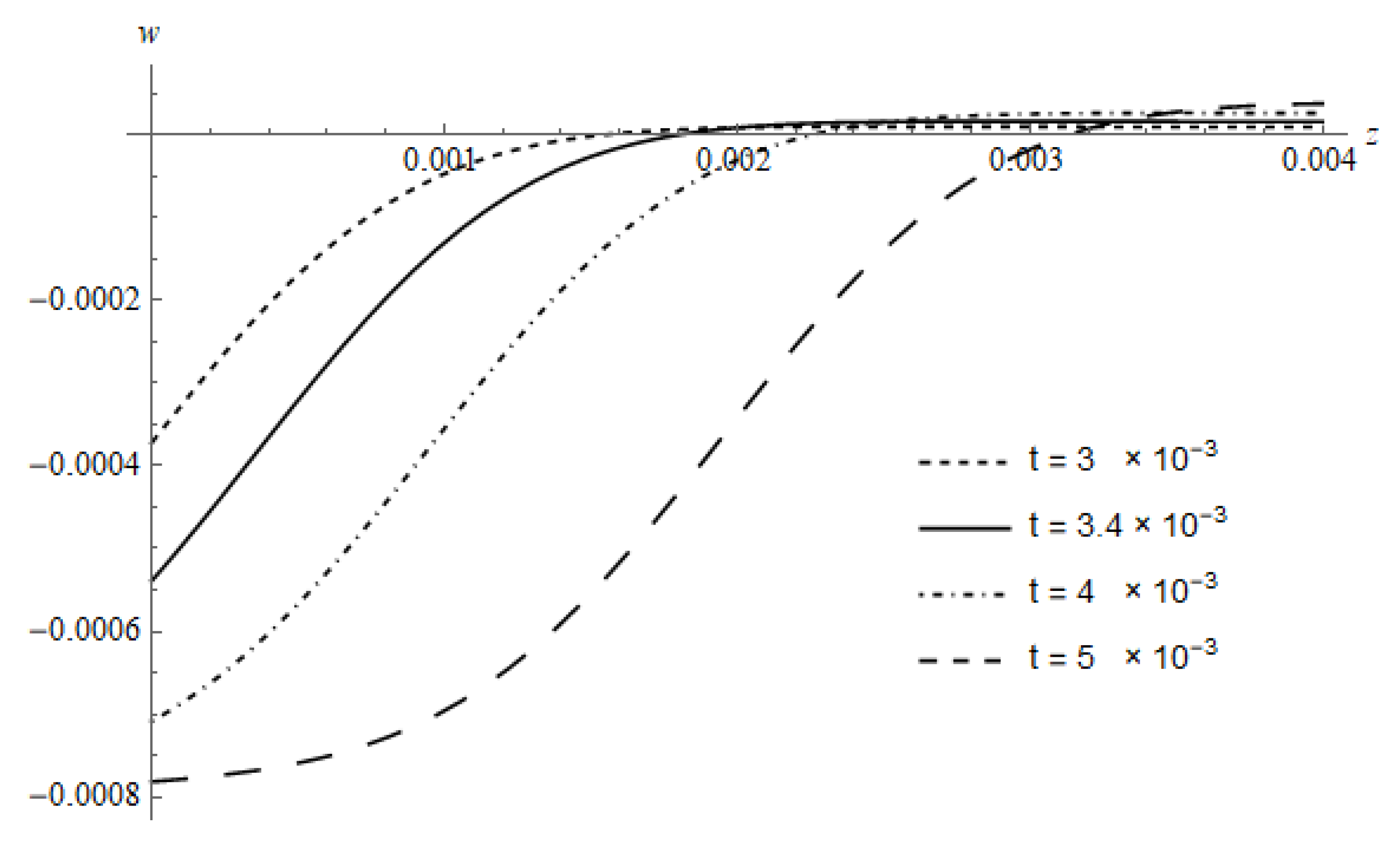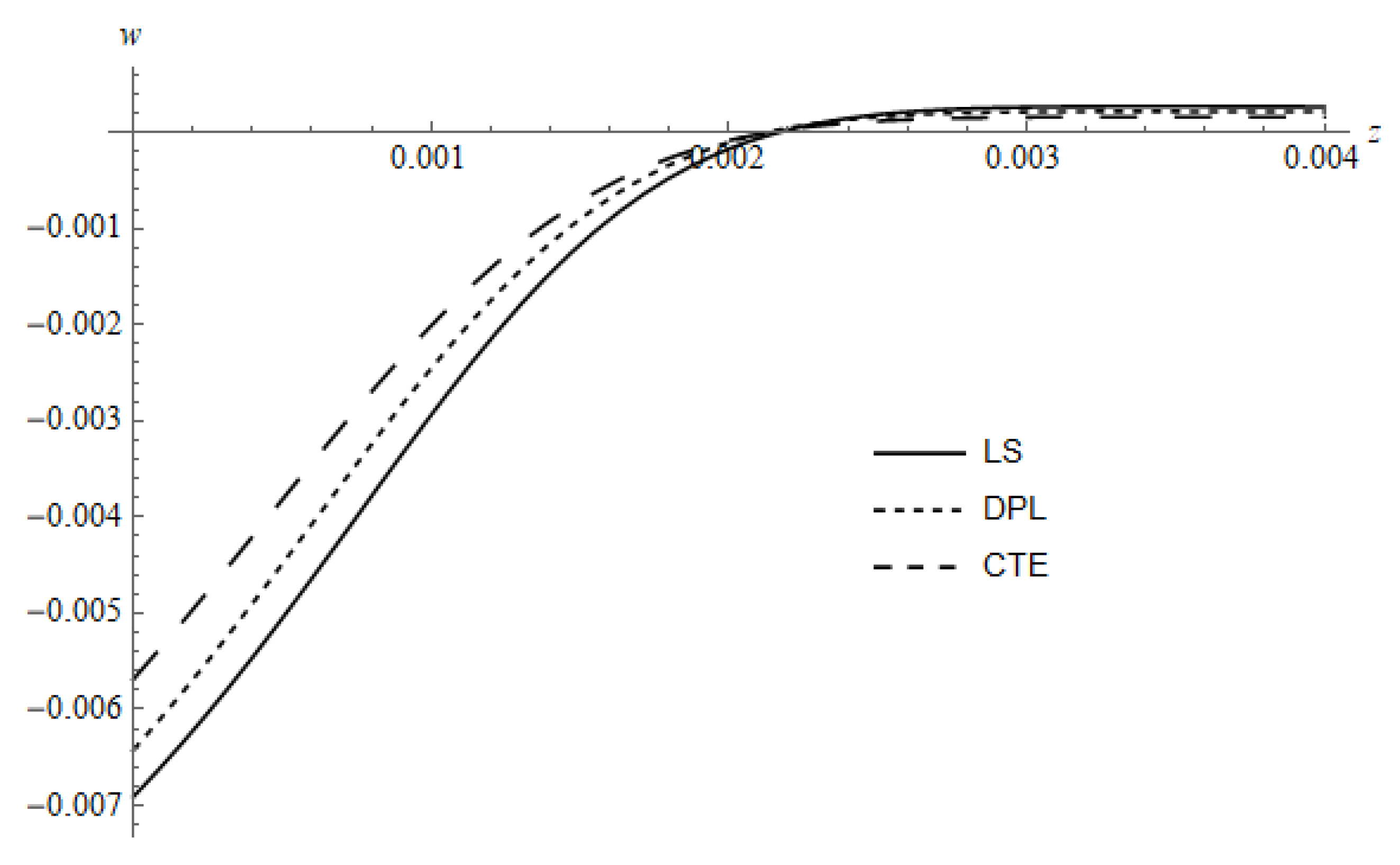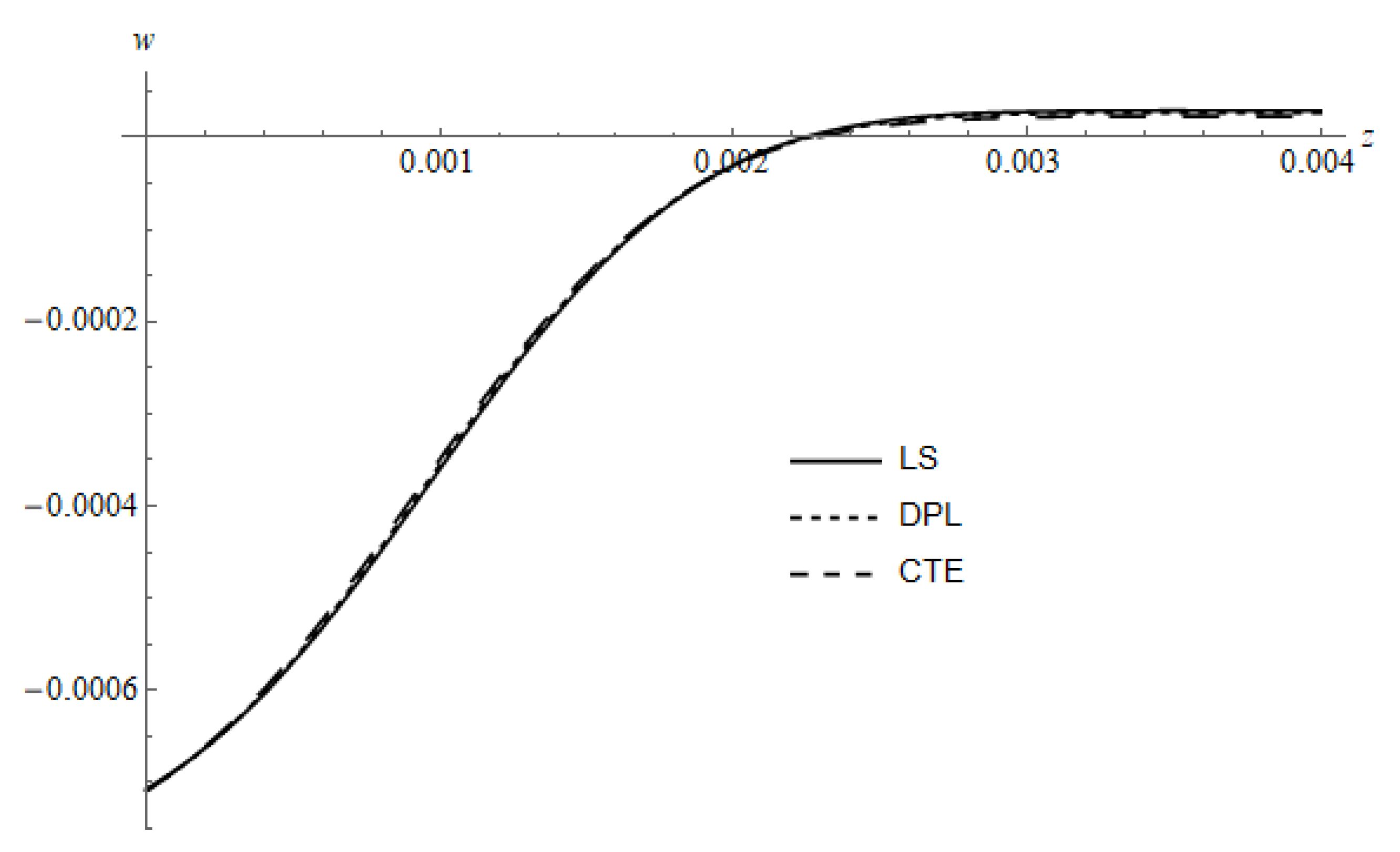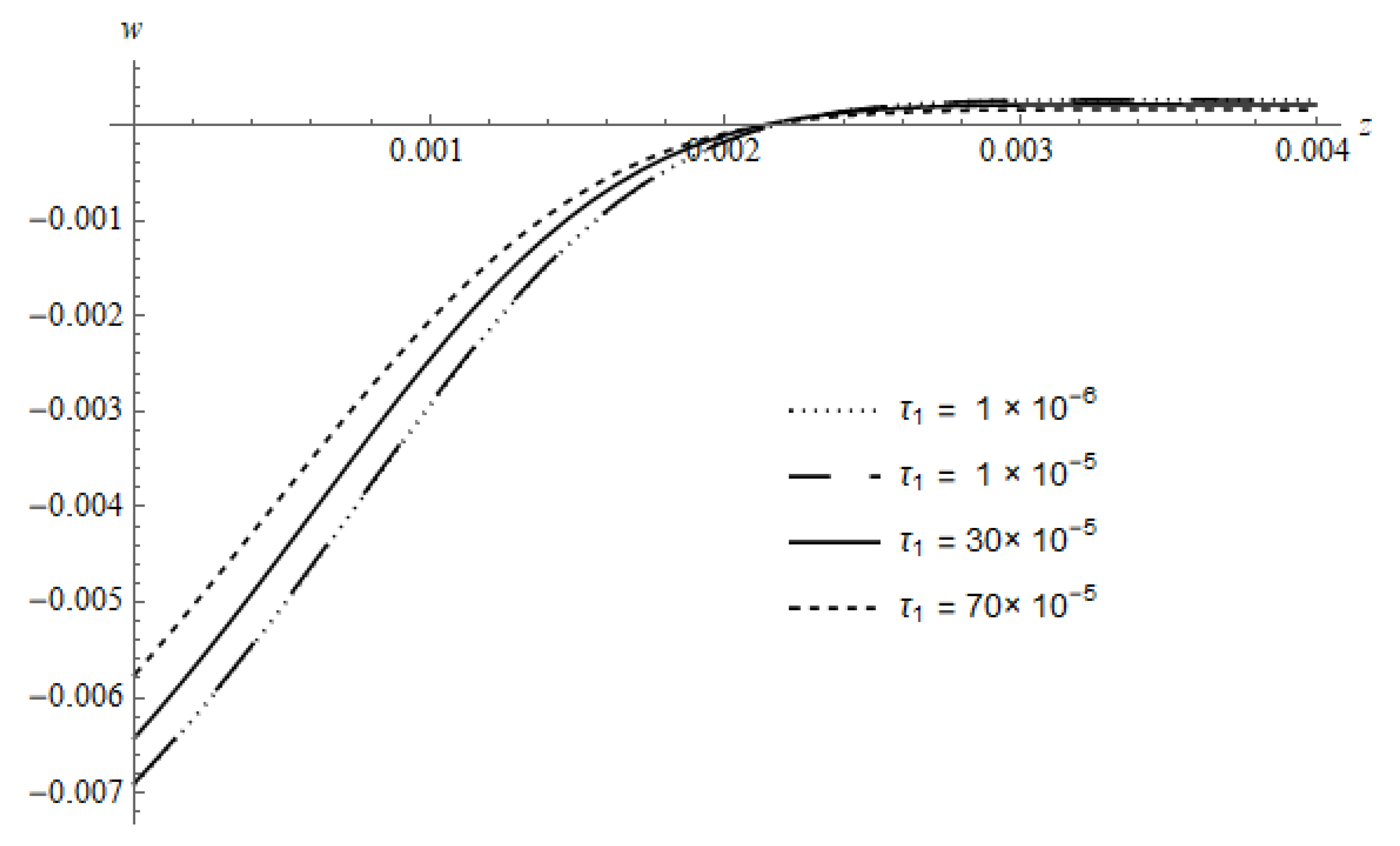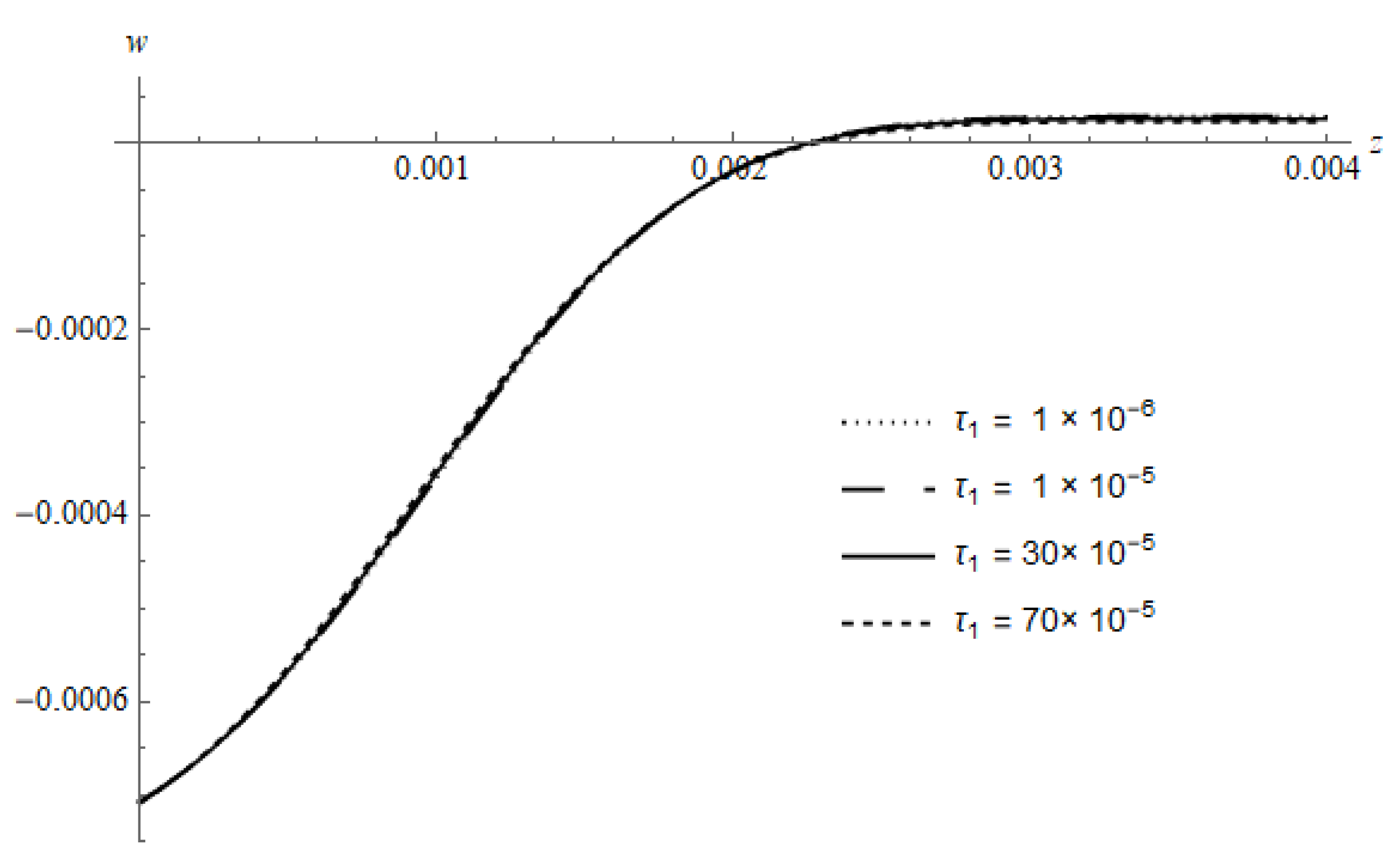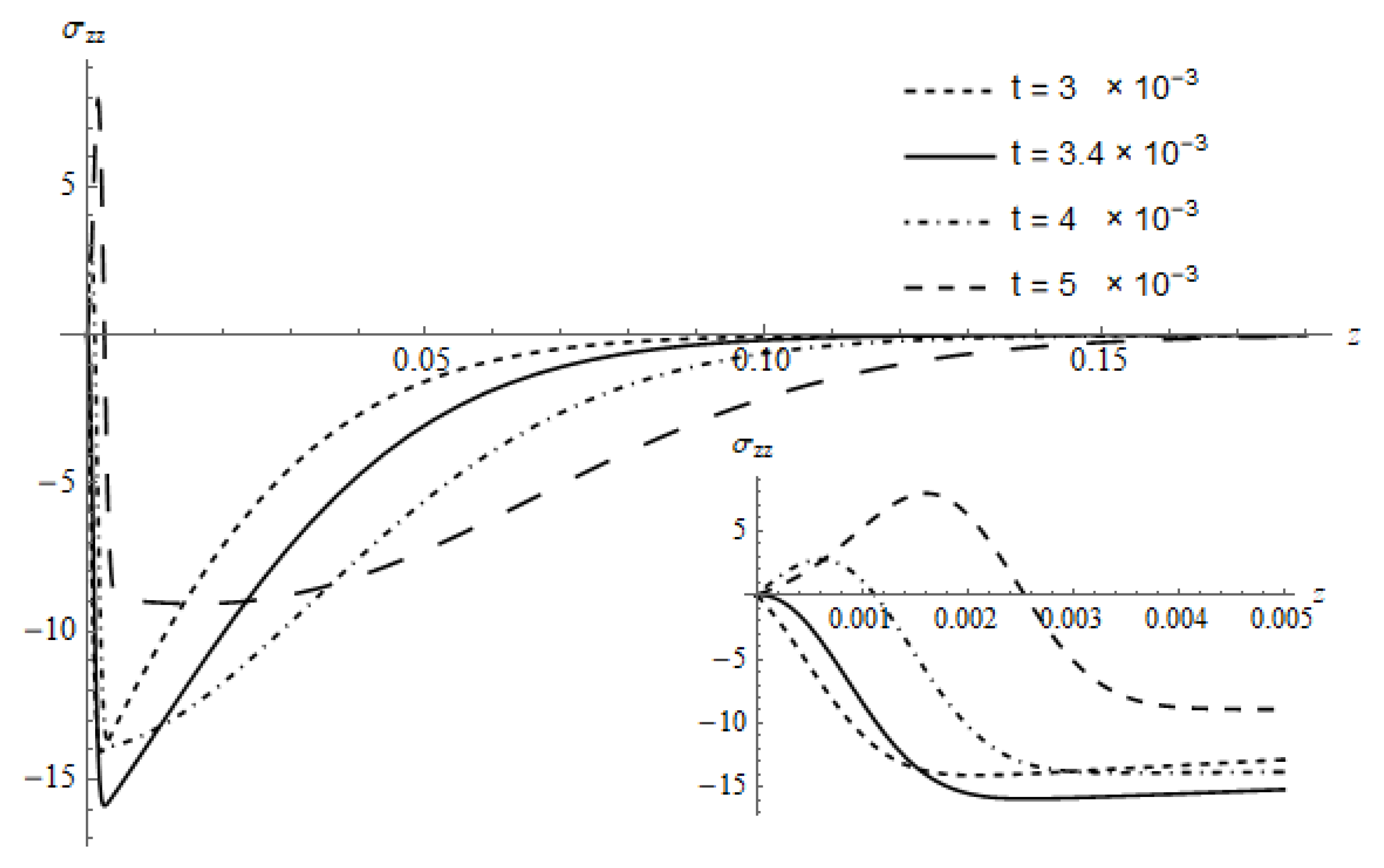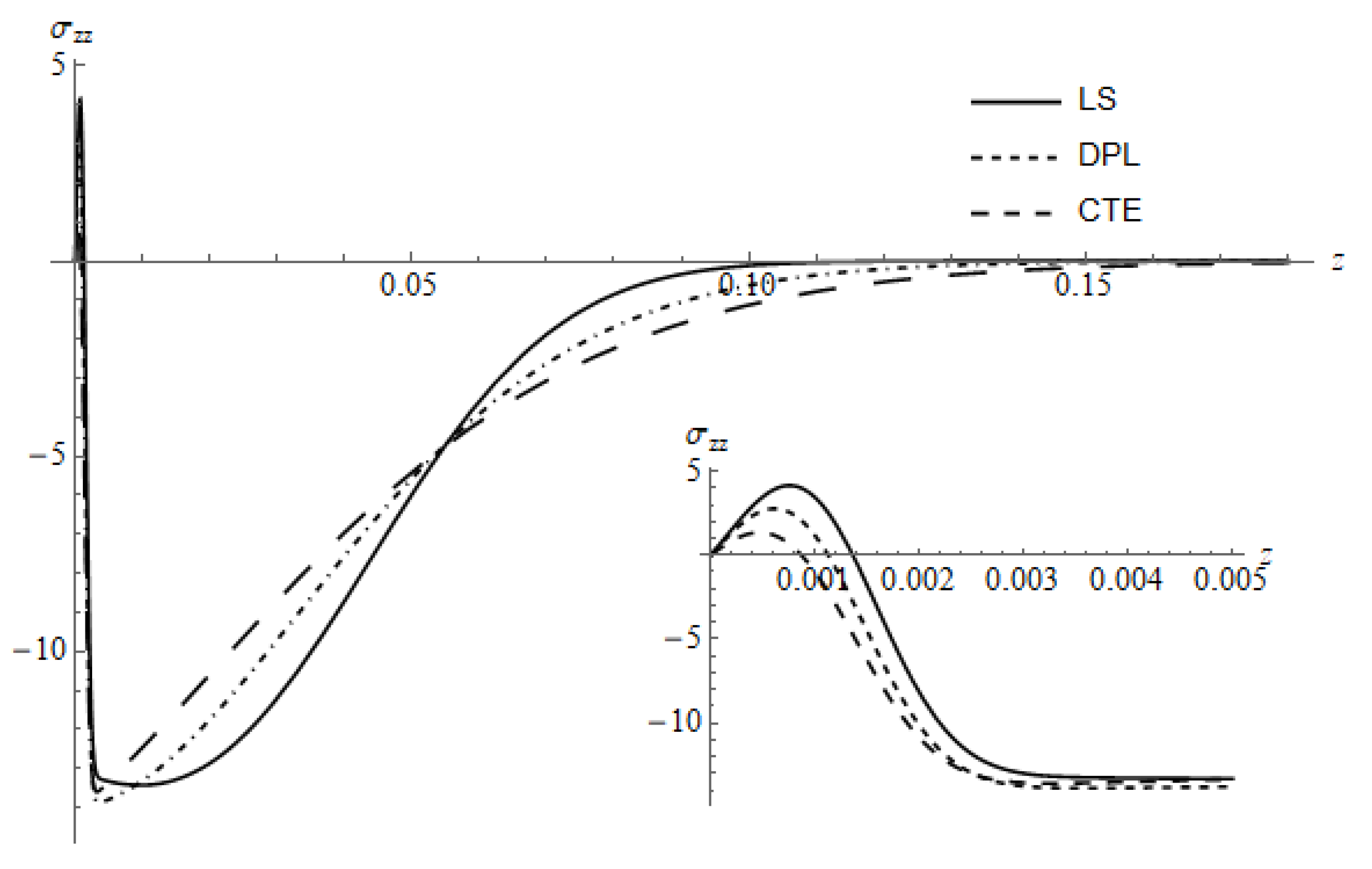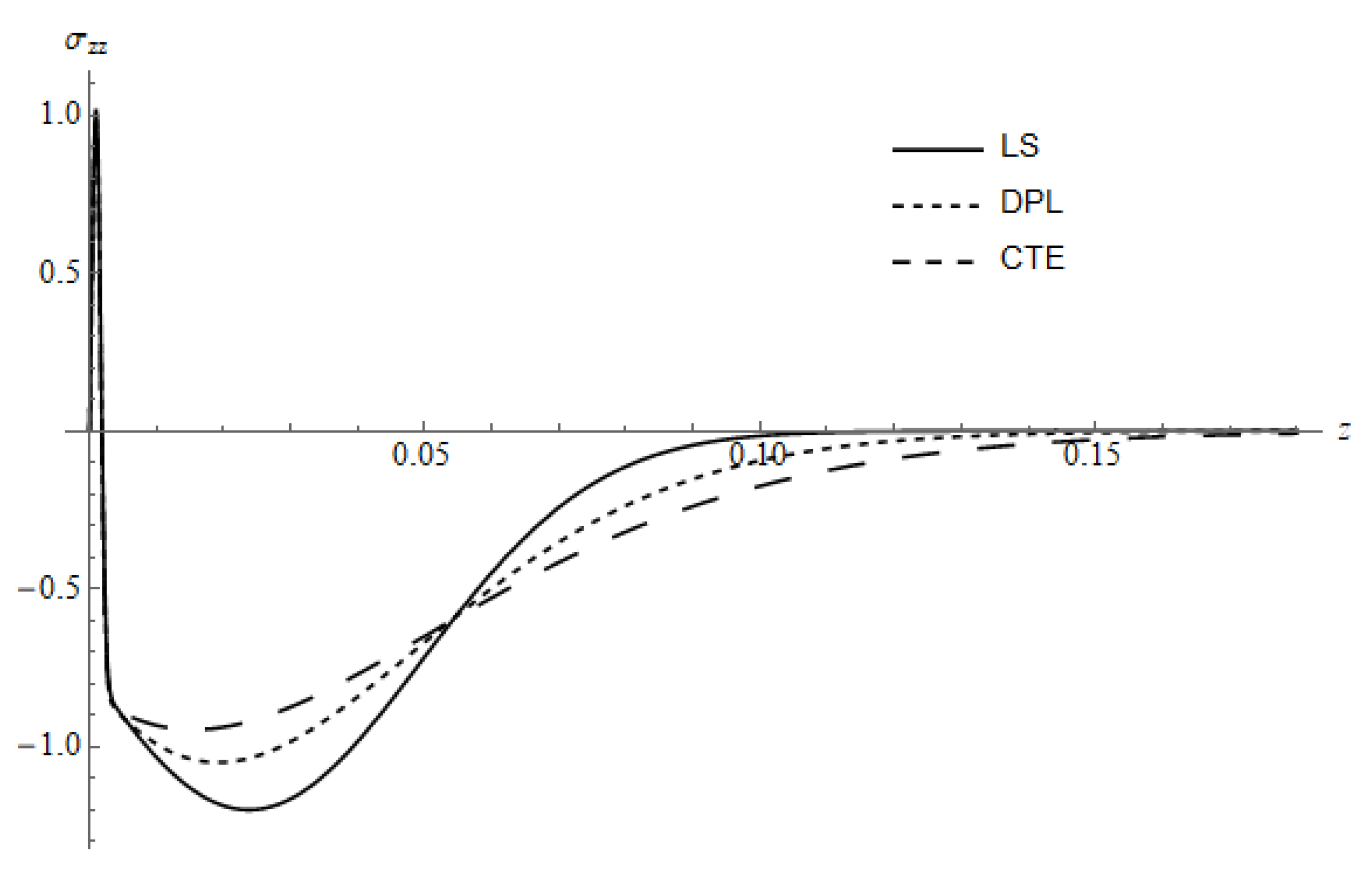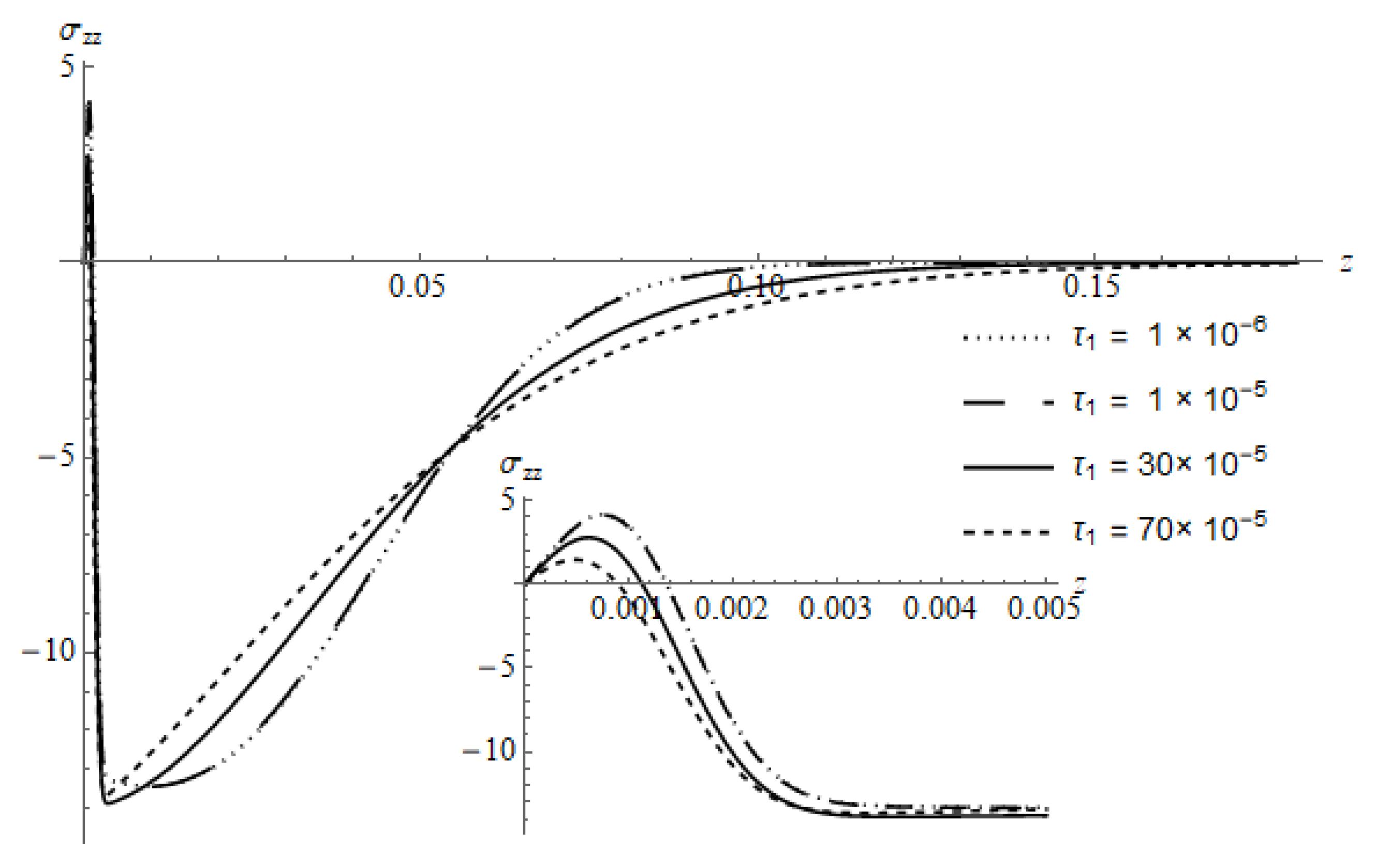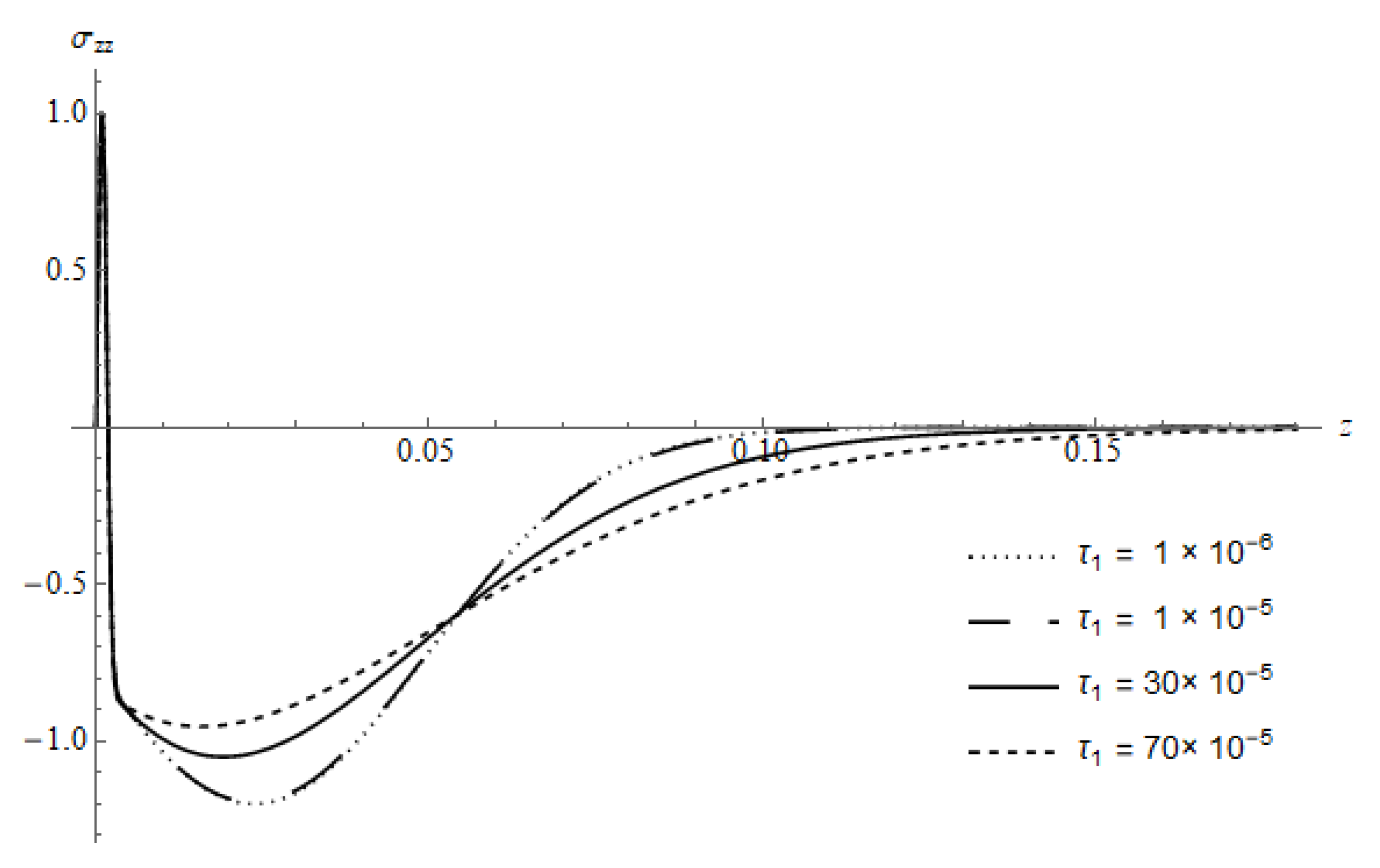1. Introduction
A rapid growth in scientific research of the thermoelasticity field was observed after Biot (1956) [
1] introduced the coupled theory of thermoelasticity (CTE) to fade the flaws of the classical uncoupled theory, stating that the elastic disturbance has no influence on temperature and the temperature waves travel with infinite speeds. Although this theory repairs the first defect by coupling between temperature and strain, the energy equation of this theory was based on Fourier’s law and, thus, its heat waves still travel with infinite speed. Employing Biot’s model Hetnarski [
2,
3] has discussed some remarkable problems in this direction. Furthermore, the work done by Boley and Tolins [
4] considered a good contribution.
The defect of the infinite speed in Biot’s theorem was eliminated by the generalization introduced by Lord and Shulman in 1967, this generalization was known as the generalized theory of thermoelasticity with one relaxation time (LS) [
5]. The energy equation of the latter theory was constructed on a new law of heat conduction instead of Fourier’s law and, thus, the defect of infinite speed was repaired. As significant contributions in the context of this theory, we mention the proofs of uniqueness theorems under different conditions by Ignaczak [
6,
7]. Furthermore, Sherief el al. [
8,
9,
10] obtained solutions of some thermoelastic problems by employing Lord and Shulman’s theory.
Many models such as [
11,
12,
13] have been introduced to be generalizations to Biot’s theory, in which the generated heat waves travel with finite speeds. One of the substantial models was the generalized theory with dual-phase-lag (DPL), which was developed by Ozisik and Tzou [
14] and Tzou [
15,
16]. In this model, Fourier’s law was replaced by an approximation that includes two distinct time translations signifying the phase lags of temperature gradient and heat flux. RoyChoudhuri [
17] employed the DPL model to study the disturbances in an elastic 1D half-space subjected to two different boundary conditions. Using the DPL model, Aboelregal [
18] obtained the solution of a 1D semi-infinite medium whose boundary plane was exposed to thermal shock. EL-Karamany and Ezzat [
19] published a considerable study on the Dual-Phase-Lag model. Abbas and Zenkour [
20] studied the dual-phase-lag model on thermoelastic interactions in a half-space exposed to a ramp-type heating by applying the finite element method. Marin et al. [
21] studied the well-posed dual-phase-lag model of a thermoelastic dipolar material.
One of the significant sources leading to thermal influences is the pulsed laser, which gives a high density in small periods of time and this, in turn, yields a great importance economically. Since lasers were founded, many applications have been made in science, mechanics and engineering based on their specific properties [
22]. Many theoretical studies have been conducted to study thermoelastic responses induced by laser radiation [
23,
24,
25]. Henain et al. [
26] studied the surface illumination of a 2D thermoelastic homogeneous semi-infinite medium. Yossef and EL-Bary [
27] applied four thermoelastic theories to study the response in an elastic half-space induced by laser pulse whose temporal profile is non-Gaussian. Allam and Tayel [
28] obtained a solution for a 1D thermoelastic functionally graded half-space heated uniformly by a surface absorption of pulsed laser having Gaussian temporal profile. Abbas and Marin [
29] studied the thermoelastic interaction induced by laser pulse in a 2D half-space and introduced an analytical solution in the context of the generalized theory with one relaxation time. Tayel and Hassan [
30] employed the fractional order theory of thermoelasticity to study the effect of the fractional parameter in the existence and absence of heat losses in a thermoelastic half-space heated uniformly by surface absorption of laser radiation.
The aims of this work are to investigate the thermoelastic interactions in a half-space induced by volumetric absorption of laser radiation in the existence and absence of heat losses by employing three different theories of thermoelasticity, namely, DPL, LS, and CTE, and to study the influences of the phase lag of the temperature gradient of the dual-phase-lag theory. Moreover, the response of LS and CTE models will be compared with the response induced by surface absorption technique in a previously published paper [
30].
2. Problem Formulation and Basic Equation
We consider a laser beam to be incident uniformly in z-direction perpendicular to a homogeneous and isotropic thermoelastic half-space whose initial temperature is . The irradiated surface is taken to be traction free and subjected to heat losses whose coefficient is temperature-dependent. At the irradiated surface, a part of the laser radiation will be reflected, while the rest will be absorbed into the medium to be converted into heat and, consequently, thermoelastic waves will be generated.
Due to the uniform illumination of the surface , the problem will be 1D and all studied fields will be functions of z and t only, and consequently, the displacement vector will have one component, namely , while the other components are vanishing.
Following the Dual-Phase-Lag theory (DPL) [
15,
16], the equations governing the thermoelastic waves in the absence of body forces for a one-dimensional problem are
where
stand for the absolute temperature, thermal conductivity, denisty, specific heat at costant strain, heat source per unit volume, and reference temperature, which chosen such that
. Furthermore,
, in which
and
are Lamé’s constant and
is the coefficient of linear thermal expansion.
and
are the phase lag of the temperature gradient and heat flux, respectively, where
.
The energy equations of LS and CTE models can be generated from Equation (
1) by setting
and
, respectively.
where
is the transition coefficient of the irradiated surface,
is the linear absorption coefficient of the material,
is the maximum value of the laser power density and
is the time dependent laser pulse profile.
Using Equation (
2), Equation (
1) can be written as
where
is the normal stress.
For a 1D problem, the strain components are
Thus, the volume dilatation will be
The non-vanishing stresses are:
where
is the temperature increment.
Using Equation (
7a), Equation (
4) can be written as
Now, the boundary conditions can be expressed as:
where
is the surface temperature and
h is the heat transfer coefficient.
Also, the initial conditions are:
For simplicity, we introduce the following non-dimensional variables:
Making use of the non-dimensional variables after dropping the stars, Equations (
3), (
8) and (7) can be written respectively as:
where
The non-dimensional form of (9) is given as:
6. Results
Figure 1 represents beside the curve of the chosen pulse profile
, the time dependent surface temperature
for three different theories, namely LS, DPL and CTE calculated for
, the DPL curve calculated for
. The curves show,
increases with increasing the exposure time until the temperature reaches its maximum and then begins to decrease. This behavior can be interpreted as follows: at the beginning of the irradiation process, the conversion rate of the absorbed energy into heat is greater than the rate of the conducted one to the surrounding; this leads to piling up the heat energy in the vicinity of the illuminated surface and, thus, temperature rise. The increment of
is continued until the converted heat energy becomes equivalent to the conducted one; at this moment, the temperature reaches its maximum. After that, the absorbed energy begins to decrease and thus the conduction becomes greater than the absorption leading to decrease the temperature. As seen, the maximum value of the surface temperature is greater in the case of the generalized theories of LS and DPL than the case of the classical coupled theory of CTE. For the three curves, the maximum is shifted to greater times than the maximum of
, but the CTE needs more time than the other theories to reach its maximum. The observed behavior can be interpreted as follows: beside the infinite speed of the heat waves of the CTE model, which leads to deeper spread of the temperature inside the medium, two different phenomena affect the spatial and temporal temperature distribution, namely, the heat conductivity described by the gradient of the temperature and the expansion of the material. While the first leads to heating the surroundings, the second will consume the heat energy in expanding the distances between particles and, thus, its potential energy increases. As observed in a later figure the CTE model having the greater spreading and the greater gradient of the spatial temperature close to the irradiated surface, so it has the smallest surface temperature. Since the maximum temperature occurs as the absorbed energy is equal to the consumed one, the LS and DPL maximum must occur more near the maximum of the laser profile
than that of the CTE, which consumes more energy in penetrating more into the medium. According to [
30], the maximum values of
for the models of CTE and LS induced by the surface absorption is greater than the case of the volumetric absorption by approximately
and its shift towards t-values is less.
Figure 2 represents
of the three theories LS, DPL and CTE calculated for
, the DPL curve calculated for
. The figure shows a different behavior from
Figure 1, where the three curves almost match with the curve of the pulse profile
; this behavior is due to the conductivity of the martial together with the cooling effect. As in
Figure 1, the curves of LS and CTE induced by volumetric absorption are smaller than the curves of the surface absorption [
30].
Figure 3 represents
of the DPL model calculated for
and different values of
at a fixed value of
. The figure indicates that as
takes value near
,
behaves approximately like the classical coupled theory (CTE) and as
takes values far from
,
behaves approximately as the generalized theories in which this behavior is valid until a certain value approximately
after this value the curves will be coincided for any values of
. The figure shows also that as
decreases, the maximum of
increases. After
reaches its maximum value the slop of the curves are inverted with respect to the slop before the maximum value.
Figure 4 illustrates the spatial distribution of the temperature of the DPL model calculated for
and
at several times. The curves reveal a clear finite velocity which appears through the strong gradient at diverse locations and the increasing deep penetration as the time increase. The figure agrees with
Figure 1, where its maximum temperature is located at the irradiated surface and occurs at a time greater than the time of the pulse profile
. After the time at which the temperature reaches its maximum (
), a small gradient near the irradiated surface is observed owing to the decay of the absorbed energy inside the medium.
Figure 5 illustrates the spatial distribution of the temperature of three different models, LS, DPL and CTE, calculated for
and
, the DPL curve calculated for
. The figure shows that the CTE model penetrates into the medium more than the other models (DPL and LS) and has the greatest gradient in the vicinity of the irradiated surface. This behavior is due to its infinite velocity of propagation. As seen, the maximum temperature of the LS model is smaller than the maximum of the other models and occurs near the surface of the target. This behavior is due to its relatively greater displacement at the irradiated surface which can be seen clearly in a later figure. This leads to store the heat energy in a mechanical potential energy and, therefore, slightly cools the surface due to heat conduction. Furthermore, the DPL model appears as a case between the LS and CTE. For the CTE and LS in the case of volumetric absorption, the temperature is smaller and the penetration depth is greater compared with the corresponding case of the surface absorption [
30].
Figure 6 illustrates the spatial distribution of the temperature of the three different models (LS, DPL, and CTE) calculated for
at
, the curve of the DPL calculated for the value
. The figure shows a pronounced effect for the cooling parameter, where the maximum of the temperature does not appear at the irradiated surface like the previous figure, but it is shifted into the medium. According to [
30], for the LS and CTE models in the case of volumetric absorption, the value of the temperature at the irradiated surface and at the location where the maximum occurs is smaller than the case of surface absorption, while the penetration and the maximum locations do not affect the mechanism of heating. This is because of the greater thermal expansion in the case of the volumetric absorption than the surface absorption.
Figure 7 represents the spatial distribution of the temperature of the DPL model calculated for
at
and different values of
at a fixed value of
. It is observed that as
approaches the value of
, the penetration into the medium increases and as it takes values farther from
the gradient of temperature decreases in a region closes to the surface and then increases after that. This figure, much like
Figure 5, agrees with
Figure 3 from where the behavior goes towards the generalized or classical coupled theories.
Figure 8 represents the spatial distribution of the temperature of the DPL model calculated for
at
and different values of
at a fixed value of
. The effect of the cooling is evidently appearing where the maximum temperature is shifted towards greater z-values. Furthermore, this figure is like
Figure 6.
Figure 9 illustrates the spatial distribution of the displacement
w of the DPL model calculated for
and
at several times. The curves show that
w appears in a region close to the irradiated surface; this behavior is due to the delayed waves of the displacement, which come as a result of the heating process. Negative signs are characterizing the displacement, which is due to the geometry of the target, where the positive direction is pointed into the medium, while the displacement grows in the reverse direction. The figure shows a pronounced increase in both the magnitude and the penetration into the medium, with increasing time; this is due to the increased penetration of the temperature with time.
Figure 10 represents the spatial distribution of
w for three different models, namely, LS, DPL and CTE; the curves calculated for
and
, the curve of the DPL model calculated for the value
. The figure shows that the value at the irradiated surface is greater for LS and DPL models than the CTE model while the penetration does not affect; this behavior can be interpreted from
Figure 5 where the gradient of the temperature of LS and DPL models is smaller than the gradient of the CTE. According to [
30], the curves of the CTE and LS for the surface absorption are greater than the case of the volumetric absorption, while the penetration is approximately equal.
Figure 11 represents
w for three different models, namely LS, DPL and CTE, the curves calculated for
and
, the curve of the DPL model calculated for the value
. The figure shows that due to cooling, the displacement of the three theories are practically the same. Furthermore, the penetration into the medium is slightly greater in the case of
than that of
in
Figure 10. In the case of cooling, the case of surface absorption shows smaller magnitude and penetration than the case of volumetric absorption [
30].
Figure 12 represents the spatial distribution of
w of the DPL model calculated for different values of
at a fixed value of
at the time
with
. It is noted from the figure that the displacement is increased with decreasing
, while the penetration is not affected.
Figure 13 represents
w of the DPL model calculated for different values of
at a fixed value of
at the time
with
, from the figure, a very weak effect for
with the existence of cooling being observed, where the curves seem to coincide.
Figure 14 represents the spatial distribution of
of the DPL model calculated for
and
at several times, beside a small figure representing
near the irradiated surface. According to Equation (13), the behavior of
is due to the effect of the gradient of the displacement and the temperature. The gradient of the displacement is practically has its effect in a region very close to the irradiated surface and its effect increases with time (see
Figure 9). As z increases, the effect of the gradient of
w vanishes and then the effect of the temperature appears evidently as in
Figure 4. For the times (
,
) or before the temperature reaches its maximum, the stress does not possess a positive peak in the vicinity of the irradiated surface, the positive peak appears for (
,
).
Figure 15 represents
for three different models, namely LS, DPL and CTE, calculated for
and time
, the curve of the DPL model calculated for the value
. In the vicinity of the irradiated surface, the positive peak of
is greater for the generalized theories (LS, DPL) than the CTE model. By increasing the z-value, the temperature effect becomes pronounced and shows the same behavior as in
Figure 5. According to [
30], both positive and negative peaks of the stress
are greater in the case of surface absorption than the case of the volumetric absorption for LS and CTE models.
Figure 16 represents
for three different models, namely LS, DPL and CTE, calculated for
and time
, the curve of the DPL model calculated for the value
. This figure agrees with
Figure 6 and
Figure 11,where in a region closest to the irradiated surface, the cooling has a slight effect on displacement and so its gradient. By increasing the z-value, the behavior of the temperature appears with the cooling effect. The figure agrees with the previous one in terms of the effect of the technique of absorption [
30].
Figure 17 represents the spatial distribution of
of the DPL model calculated for different values of
at a fixed value of
at the time
with
. Close to the irradiated surface, the positive peak increases with a decreasing value of
. By increasing the z-value
shows the same behavior of the temperature for the same case (
Figure 7).
Figure 18 represents
of the DPL model calculated for different values of
at a fixed value of
at time
with
. In the vicinity of the irradiated surface, the stresses seem to coincide with each other, which is due to the cooling effect. By increasing the z-value, the behavior of the temperature with cooling appears evidently.

